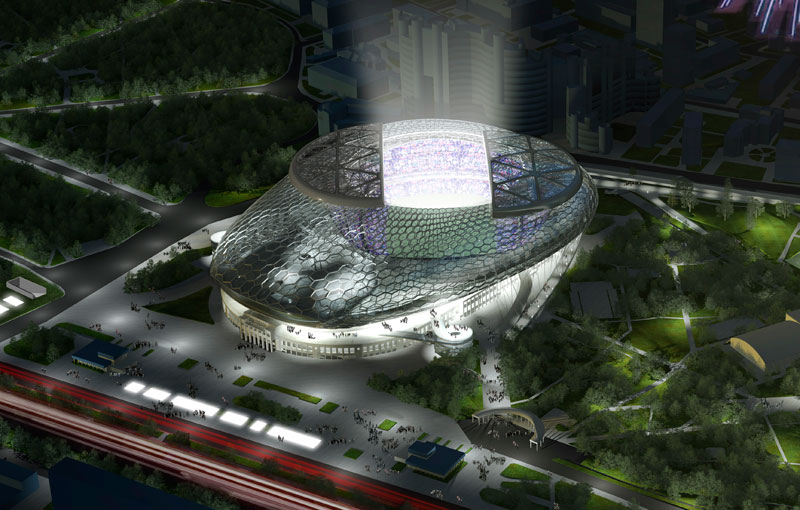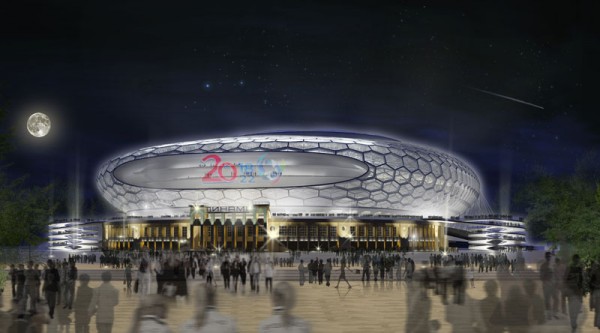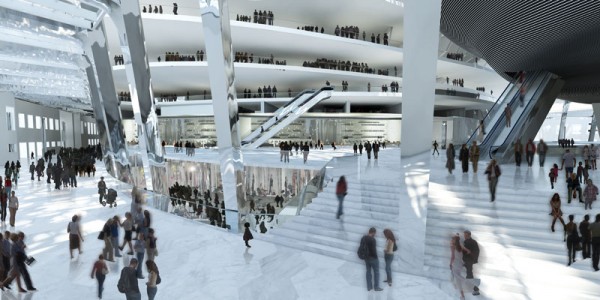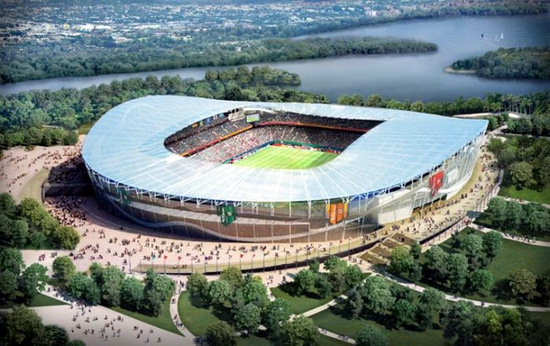




MOSCOW (DYNAMO STADIUM). Capacity: 44,920 TBC. Dynamo Stadium will be located six kilometres from Moscow city centre and a renewed version of the old Dynamo Stadium which was originally built in the 1920s.

MOSCOW (SPARTAK STADIUM). Capacity: 46,990 TBC. On the outskirts of the capital approximately 25km from the city centre, the new stadium will finally provide Spartak Moscow with their own stadium for the first time in the club’s 75-year history.

MOSCOW (STADIUM MOSCOW REGION). Capacity: 44,257 TBC. Another stadium on the periphery of the city, the ‘Moscow Region’ venue will be situated within a rural landscape and boast various sporting facilities. Organisers insist transport infrastructure will be sufficient for hosting World Cup games.

ST PETERSBURG (NEW STADIUM). Capacity: 62,000. Russia’s second city, with a population of 4.5 million, is a picturesque and historical city popular with tourists. In the north-west of the country, the city’s football team, Zenit, have emerged as a wealthy footballing power in world football over recent years. A new stadium, designed to resemble a spaceship and with a capacity of 62,000 is being built for the World Cup in place of the old Kirov Stadium. Work has been disrupted due to funding and logistical issues.

KALININGRAD (STADIUM KALININGRAD). Capacity: 45,015. The seaport city of Kaliningrad is located between Poland and Lithuania on the Baltic Sea with a population of around 430,000. The ‘star-like’ stadium complex will be situated on an island surrounded by the Pregolya River and overlook the city centre and harbour.

KAZAN (NAME TBA). Capacity: 45,015. Home to many universities as well as recently-deposed domestic champions and Champions League regulars Rubin Kazan, the city is constructing a new 45,015-capacity stadium in which the team will reside. The ground will be built on the western edge of the Volga River.

NIZHNY NOVGOROD (STADIUM NIZHNY NOVGOROD). Capacity: 44,899. Also located on the Volga River, Nizhny Novgorod has a 1.3 million-strong population and is on the UNESCO list of 100 cities of great history and culture. Like many other Russian host stadia the ground will be placed on a site bordered by a river, to the north of the city.

YAROSLAVL (STADIUM YAROSLAVL). Capacity: 44,042 TBC. Located 250km north-east of Moscow, the city’s old town is a UNESCO World Heritage site while the industrial district is one of Russia’s most prominent. The stadium will be an urban venue in the centre of the city and built on the site of FC Shinnik Yaroslavl’s ground.

SAMARA (STADIUM SAMARA). Capacity: 44,918 TBC. Yet another host city which needs to build a new stadium from scratch, Samara has strong transport links with a major airport, railway station and river port. The new ground will be situated on Koroviy Island at the confluence of the Volga and Samara Rivers and is promised to be an “iconic venue” according to organisers.

VOLGOGRAD (STADIUM VOLGOGRAD). Capacity: 45,015 TBC. A city of 1.1 million residents with metal and oil interests, Volgograd – formerly Stalingrad – will construct a new stadium on a 32-hectare site in a park on the Volga River banks. The ground will be the centrepiece of an urban landscape park near the Mamayev Mound memorial which commemorates the World War II battle of Stalingrad.

SARANSK (STADIUM SARANSK). Capacity: 45,000 approx TBC. A small city of just over 300,000 residents, Saransk is the capital of the Republic of Mordovia in the Volga Basin. The new stadium is due to be completed by 2012 for the city’s millennium celebrations. Unusually, it will be built within a new business park rather than a sporting facility.

KRASNODAR (STADIUM KRASNODAR). Capacity: 50,015 TBC. Krasnodar is the “Gateway to the Caucasus Mountains” and home to three professional football clubs. The stadium is likely to be among Russia’s smaller World Cup venues and will be 14km outside the city centre on an ‘urban recreational park’.

ROSTOV-ON-DON (STADIUM ROSTOV-ON-DON). Capacity: 43,702 TBC. An environmental hub and once the home of the Cossacks, the city also boasts Russian Premier Liga side FC Rostov. The stadium will be close to the city centre on the idyllic river banks with designers vowing to remain true to the picturesque landscape on the Don River.

SOCHI (STADIUM SOCHI). Capacity: 47,659 TBC. Also hosting the 2014 Winter Olympics, the Black Sea resort will enjoy four incredible years with the World Cup also coming to town. The stadium, to be used for both the Olympics and World Cup, will be located just 150 metres from the sea offering an incredible setting.

YEKATERINBURG (STADIUM YEKATERINBURG). Capacity: 44,130 TBC. An Asian city bordered by the Ural Mountrains, Yekaterinburg is Russia’s fifth-largest city and dates back to 1723. The stadium will be a redevelopment of the existing Uralmash Stadium and will reflect the city’s Asian heritage in terms of design.
1. Vấn đề giao thông

2. Liệu giá cả tại nước Nga có “mềm”?

3. Các sân vận động thì sao?

4. Sự hâm mộ của khán giả

5. Sự quan tâm của dư luận đến bóng đá

Cầu thủ người Nga, Andrei Kanchelskis, siêu tiền vệ của Manchester United một thời cũng phải thừa nhận rằng “không như người Nga, người Anh luôn tôn thờ bóng đá, họ không thể tưởng tượng cuộc sống của họ sẽ ra sao nếu không có môn thể thao này. Để người hâm mộ tại Nga có thể cuồng nhiệt với bóng đá như vậy, có lẽ chúng tôi sẽ còn rất nhiều việc phải làm”.![]()
6. Kinh nghiệm tổ chức World Cup của nước Nga






















Hello Mr. Dat Nguyen,
ReplyDeleteI wonder if I live or work in US? Can have your personal email? By the way, I have your site in my favorite link @ http://banbecuatoi.com/blog/ that I intend to do similar topics about the world science/technology vs...
Cheers,
Hoang Ngo
hoang.van.ngo@gmail.com